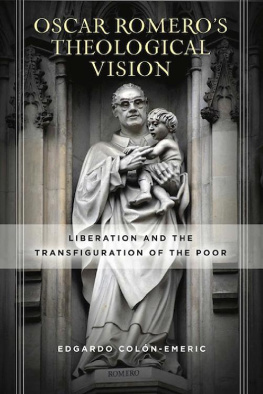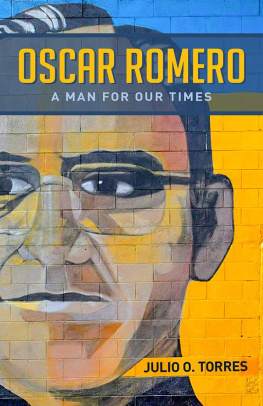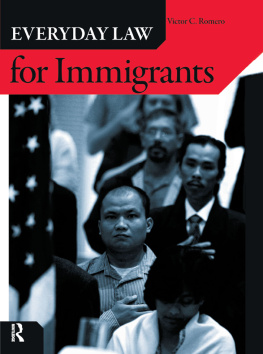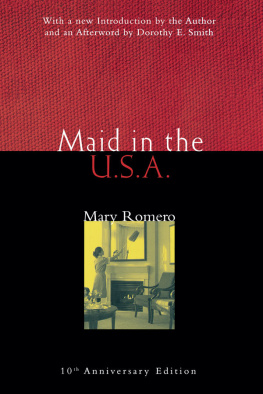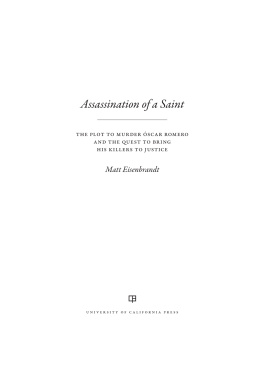scar Romeros Theological Vision
EDGARDO COLN-EMERIC
scar Romeros
Theological Vision
Liberation and the Transfiguration of the Poor
UNIVERSITY OF NOTRE DAME PRESS
NOTRE DAME, INDIANA
University of Notre Dame Press
Notre Dame, Indiana 46556
undpress.nd.edu
Copyright 2018 by the University of Notre Dame
All Rights Reserved
Published in the United States of America
Library of Congress Cataloging-in-Publication Data
Names: Colon-Emeric, Edgardo Antonio, 1968 author.
Title: Oscar Romeros theological vision : liberation and the transfiguration of the poor / Edgardo Antonio Colon-Emeric.
Description: Notre Dame : University of Notre Dame Press, 2018. | Includes bibliographical references and index. |
Identifiers: LCCN 2018043823 (print) | LCCN 2018044729 (ebook) | ISBN 9780268104757 (pdf) | ISBN 9780268104764 (epub) | ISBN 9780268104733 (hardback : alk. paper) | ISBN 0268104735 (hardback : alk. paper)
Subjects: LCSH: Romero, scar A. (Oscar Arnulfo), 19171980. | El SalvadorChurch history20th century. | Liberation theology.
Classification: LCC BX4705.R669 (ebook) | LCC BX4705.R669 C65 2018 (print) | DDC 230/.2092dc23
LC record available at https://lccn.loc.gov/2018043823
This e-Book was converted from the original source file by a third-party vendor. Readers who notice any formatting, textual, or readability issues are encouraged to contact the publisher at
To Cathleen, Lito, y Benben
And to my hermanas y hermanos in Central America
Cristo vive. De verdad vive.
CONTENTS
ACKNOWLEDGMENTS
For the past few years, Romero has been a constant companion. I have had his image before me as I read scripture and pray. The downloaded audio files of his homilies have been playing in my ears as I have gone running on trails. The altar on which he was killed has time and again been a place where I have recommitted my life and scholarship to Jesus. And yet, a Puerto Rican, Methodist clergyperson like myself writing a book about a Salvadoran Catholic martyred bishop is not an obvious combination. An acknowledgment of the oddity of this occurrence is in order by way of testimony and thanksgiving.
I first heard of scar Romero when I attended a Jesuit high school in Puerto Rico. The priests who taught there were very attuned to the situation in Central America, and they shared with us news about what was happening in these countries during the late 1970s and early 80s. When the Paulist film Romero hit the screens in 1989, I went to see it. The actor who played the role of Romero, Raul Julia, had actually graduated from my high school. The release of this film was followed by the tragic news of the assassination of the Jesuit priests at the University of Central America. The convergence of these events marked me and contributed to my eventual abandonment of engineering studies in favor of the study of theology.
When I joined the theology faculty at Duke Divinity School in 2007, I decided to organize a Spanish reading group. I was not sure what we would read until I ran into one of the prospective members for this group in the library. There, while I was talking amid the stacks of books, my eyes fell upon a collection of Romeros homilies. The idea was born for a Romero Reading Group. We met every Wednesday to read and discuss in Spanish (and Spanglish) Romeros homily for the lectionary texts of the week. The hours that we spent with these homilies made a very strong impression on all of us. My students and I were struck by the paradoxes of this prelates teaching and way of life: a patriotic prophet, a lover of the poor and the popes, a plain priest and a powerful preacher. The more we read, the more we were humbled and inspired by the transparency of Romeros witness to Christ. The only constant in seminary is change. Students come and students go, and the Romero Reading Group would peter out after a few years, but Romeros words found fertile ground in many of us. In some of my students those seeds sprouted into essays, lectures, and even dissertations on Romero. In my case, those seeds eventually became this book, but for that to happen they needed to dig root in Salvadoran soil.
I traveled to El Salvador in the winter of 2007 to lay the groundwork for future seminary student pilgrimages in Central America. It was then that I visited the Hospitalito where Romero lived as archbishop and died as a martyr. Little did I know that this pilgrimage site would become such a central part of my professional and spiritual pilgrimage. Through a peculiar chain of events in 2010 I became the director of a program for forming Methodist pastors for churches in Central America. Since then, Romeros theology and the pilgrimage sites associated with his story (the Hospitalito, the UCA, the cathedral, and El Paisnal, to name a few) have become integrated into the curriculum of the program, the spiritual formation of teachers and students, and my research questions. Romeros episcopal motto of Sentir con la iglesia (To sense with the church) became the motto for the graduates of our Central American program and one of the pillars of my vision for theological education. More than that, the witness of the Methodists in Central America convinced me that the legacy of Romero is so rich that it overflows the Catholic Church itself.
In December 2015, the students of the Methodist Course of Study in Central America visited the town of Juaya in El Salvador. The central plaza had been the site of a mass execution of persons of indigenous ancestry in 1932. The church on the western side of the plaza is known as the Church of the Black Christ on account of the larger-than-life black-skinned crucified Jesus that hangs behind and above the altar. The locals say that the statue was carved out of dark wood by Franciscan missionaries in the sixteenth century in their effort to decolonialize the gospel by making Christ look more like the people who lived in the region. However, more recent studies have punctured holes in the missionary story. The wood for Jesus was at first a light wood. Centuries of chemical interaction between the wood and the smoke from burning candles have darkened the color of the crucified Jesus. In the church, the Central American students engaged in an exercise of lectio divina. At the foot of the Cristo Negro, they read the story of the transfiguration several times and reflected on questions like: Is it good for us to be here? What do you see when you look at this Christ transfigured into black? Do you think that the Father is well pleased in this representation of his son? What do you feel? Fear? Confusion? How does Jesus tell you to respond? Do you see the glory of Christ in this face? Do you find liberation in this image? The appearance of Jesus changed while he was praying. How has the appearance of Jesuss face changed in response to your prayers? What would you tell people about what you have seen in this place? Later we had a time to reflect on what we had felt. Some of my students interpreted this representation as misguided. Jesus was not black. And why do we look for him on the cross? He is not dead; he is risen. Others interpreted it as good news. Jesus clothes himself in dark skin because dark-skinned people have suffered for centuries in this part of the world. In effect, the piety of the people decolonialized Jesus. The more they prayed, the more his skin darkened. The encounter in Juaya sparked my thinking on the theme of this book. Whether in dusky black or dazzling white, the transfiguration of Christ upsets our expectations regarding the identity of the Son of God. This is the reason why scar Romeros theological vision could not help but be a scandal to some even as it was good news to many.
After Juaya, I developed the themes of transfiguration further through presentations at the Festival of Homiletics in Atlanta (spring 2016), the Glory of God Conference in Durham University (summer 2016), and the Romero Days Conference at the University of Notre Dame (2017). As I worked on these papers and presentations, I began to understand the way in which the study of this Central American Catholic priest confirmed the vocation of a Puerto Rican Methodist theologian. Everything is received according to the mode of the receiver, says Thomas Aquinas, and the clearer my vision of Romero became, the more evident the parallels with John Wesley. Both are exemplars of what in Methodist academic circles is referred to as practical divinity. Both are interested in a theological vision that is popular, pastoral, and prophetic. The more I understood Romeros theological vision and sought to live in accordance to it, the more authentically Methodist my witness to Christ became.
Next page
